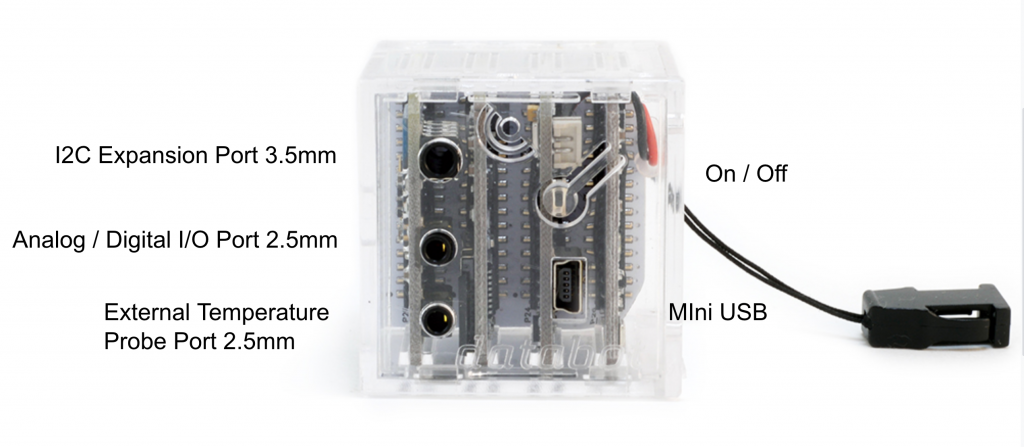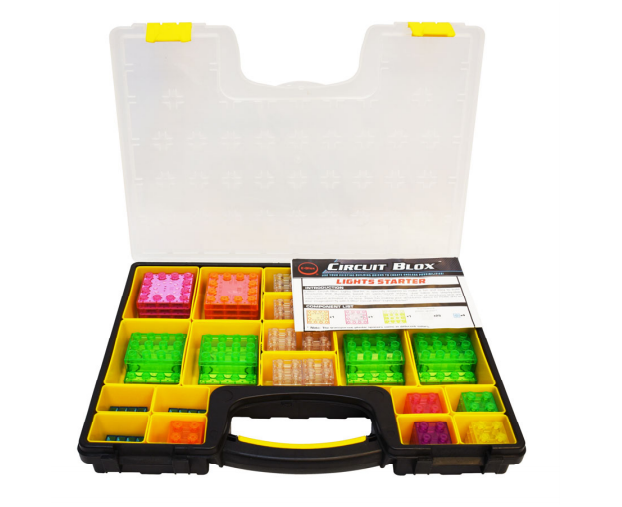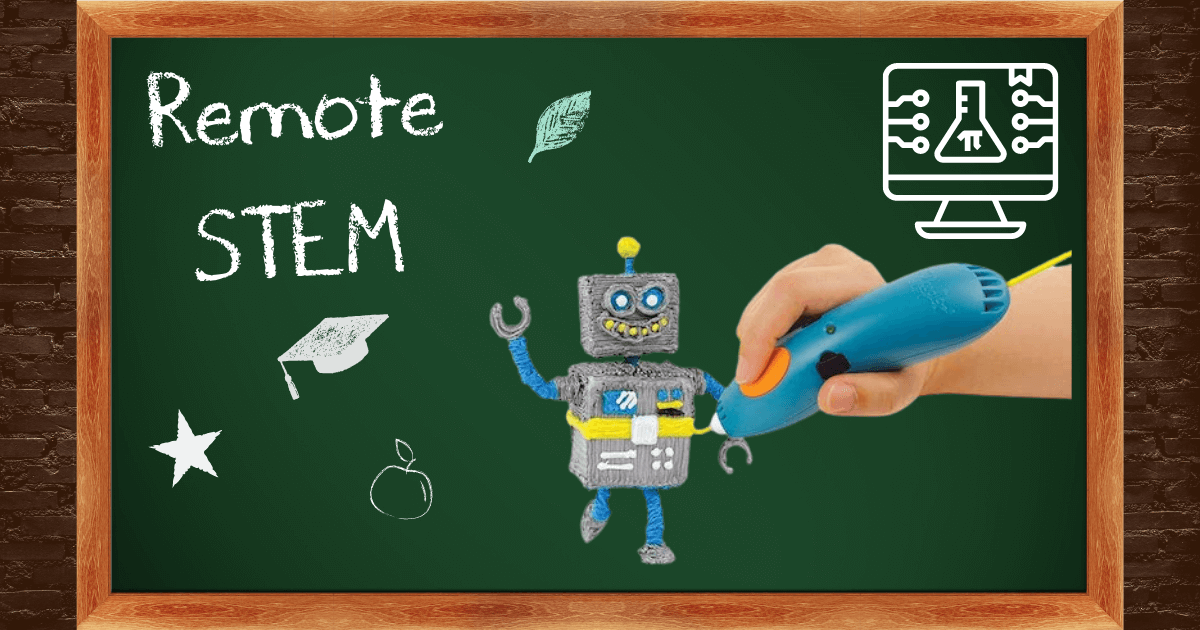A few weeks ago, we shared our top suggestions for remote and hybrid STEM tools in a blog post. There are plenty of others that we've researched, however, and placed into the Remote and Hybrid category on our store. And, this week, we thought it might be fun to highlight just five more of our favorite tech tools for helping to bring STEM learning experiences to students who are taking part in remote or hybrid learning to start the school year. And, with that said, we’d like to reiterate that remote learning doesn't require anyone to completely abandon STEM. These tools are affordable, portable, and kids can use them on a 1:1 basis.
3D Printing Tools
At first glance, you might be confused about why we'd recommend trying 3D printing in remote education. It’s okay—we were a little bit skeptical at first, too, but it is still possible. The way we look at it is that there are some 3D printing tools that are viable in remote settings and others that should probably remain solely within schools. The first 3D printing tools that are viable in remote education are the 3Doodler 3D printing pens—both the Start (for younger students) and the Create+ (for those who are a bit older). The Start pens come in packs of six or 12 (with chargers), so teachers can divide and send them home. The Create+ pens also come in packs of six or 12—plus, there’s an individual 3Doodler Create+ our store, too.
These pens provide every student with the opportunity to design and build 3D structures independently. If they haven't used these pens before, there are videos that provide creative and age-appropriate projects they can complete anywhere. Students can typically use the pens right out of their boxes and charge them while not in use. The Start can charge fully in as little as two hours and offer 60 consecutive minutes of use while the Create+ takes a bit longer to charge, but offers some additional power. The Create+ Pen must be connected to power (via the included cables) to work while the Start does not, so that's something to keep in mind. Other than that, both 3D printing pens are very safe and it’s easy to replace filaments on the go.
Now, for some actual 3D printing—well, kind of. We recently added the MakerBot SKETCH 3D printers to our store and there is one exciting and very much relevant wrinkle to this machine: Students can create 3D designs remotely. Using this MakerBot Cloud program, students can create digital versions of objects they want to 3D print from home computers. They can then pair their computer with the 3D printer, which would most likely be in the classroom or library. The MakerBot Cloud software allows them to create designs and send it right to the physical 3D printer. Teachers can then queue up the designs for students and get them printing! So, yes, it might not be what you expected when you heard 3D printing in remote education, but it’s still possible to enable this for students while they’re away from school.
Edison Robot
The Edison Robot has lots of potential to be valuable for remote learning with its versatility, portability, and coding options. In fact, we’ve worked with partners who've implemented them in various at-home projects, finding great success up to this point. They’ve done a lot with their Edison and these lower elementary kids while upper elementary and middle school students have put in the time to learn more about the robots, its functions, and how to use them for teaching programming. This is one multi-faceted approach to using the Edison, allowing some students to program while others teach important skills! We are certainly not saying this is the only way to use Edison Robots remotely since—perhaps more than any other EdTech tool—the Edison is extremely versatile, especially in remote learning.
As of now, there is not a virtual version of the Edison Robot like there is for some of the other robotics and remote STEM tools we sell. So, basically, our suggestion for using Edison in remote learning comes down to the same reasons it’s usually valuable. The Edison is extremely durable, compact, and portable, allowing educators to potentially send them home with children for use independently. Transporting Edison’s is easy since it’s basically just the robot (the EdComm cable is stored in your robot’s battery compartments). What we’re getting at is that teachers can create a complete home learning kit for students to use complete with the robot, the cable, the batteries, and a printed sheet of Edison’s barcodes—all of which should fit into a box or bag to make transportation a breeze.
Teachers can then find or create simple coding challenges for students to complete with the Edison. These include screen-free programming with the barcodes or the Edison’s other coding environments (EdScratch, EdPy, EdBlocks), which are accessible online. Children could also take videos of their Edison executing the code they wrote and send them to their teachers or post them in a public viewing area so all children in the class can see! There is also a pretty in-depth library of at-home projects for students to access and try on the Edison website. The content includes basics for getting started with your Edison, learning all about the different programming environments, and activities to create connections between learning and play! This content combined with the physical traits of the robot help make it a nice option for at-home STEM.

databot Robot
Though the databot is more pricey than some other technologies in our Hybrid & Remote category, it's still viable remotely. It does also require a computer, Internet connection, and, oftentimes, the use of a program called Google Science Journal. The databot is available as a single unit, in a 2-pack, or in a 10-pack, which could allow educators to break up these components and send individual kids home with a robot and other materials they'll need. Since it is a bit more complex than some other remote STEM tools, the databot may be best in a hybrid learning environment so students and teachers could work together at times to figure out some of the basics as well as some nuances. When used to its full potential, the databot and its many on-board sensors, including air pressure, altitude, and humidity, help it to capture real-time data students can use in authentic experiments.
Each of the three databot kits come with soft cases for easy and safe transportation of the robots. And, the robots themselves, which are cube shaped and fit in the palms of students’ hands, feature lights, speakers, BLE technology, an external temperature probe, and built-in connection ports to use with the Sphero RVR, LEGOs, and other STEM tools. Beyond that, the databot has a range of academic connections for students in all grades. Without going into too much detail, it is great for hands-on experiments or for reinforcing core science concepts in elementary school, teaching earth science, biology, or chemistry in middle school, and teaching physics, earth science, chemistry, or biology (while incorporating the Phyphox data visualization tool) in high school. Finally, it's also viable in career and technical education programs with connections to coding, electronics, data science, and more.
In addition to those original databot kits, we also offer the Camp databot—CO2 Science Kit on our store! This kit includes five modules based around the databot and, specifically, for using it in remote, hybrid, and in-person learning. The components and storage cases are tough and easily transported, helping students and teachers take part in authentic STEM learning. The five modules will include two for chemistry (Density of Gases and Chemical Reactions), two for environmental science (Indoor Air Quality and Climate Change), and one for life science (Human Respiration). The Camp databot kit is good for classroom learning, remote learning, and even afterschool STEAM clubs. It could help with supporting up to 30 students in groups as they collect data and explore CO2!
Sphero Mini
The Sphero Mini is a scaled-down version of those popular Sphero SPRK and BOLT robots. It’s also suited more for the younger children, providing a viable option for coding education as early as kindergarten. That sweet spot for the Mini is in second, third, and fourth grade and their Activity Kit, in particular, makes a nice addition to at-home STEM. The Mini does typically require a device, but many phones and tablets are also compatible with this small, robotic ball. The Activity Kit has some instruction cards for the various projects and challenges associated with the robot. Kids can control their robot in multiple ways, including drawing, block coding, and text coding once they master programming basics.
The Sphero Mini works with the Sphero Play or Sphero Edu app. With the Sphero Play app, students can drive and game, while they can use the Sphero Edu app for coding. The Sphero Play app even allows kids to drive the Mini in several different ways, including using the virtual joystick, tilting their devices, utilizing a slingshot, kick drive, and with their face! As for the gaming, these in-app games involve using the Mini as a joystick to complete fun activities from home. With the Sphero Edu app, students get the chance to code in these three different ways. Also, they can also complete challenges that help to drive home some of the important and early fundamentals of STEM. Plus, once students create programs on the Sphero Edu app, they can share them with anyone!
Inside the kit, there’s the Sphero Mini itself, 15 activity cards, a 28-piece construction set, six bowling pins, three cones, a robotic ball cover, and a micro USB cable. These activity cards each feature different guided challenges for kids to complete using the Mini and one of the apps. That construction set includes a bunch of pieces for engineering structures that the Mini can pass over, through, and around. These pieces include rails, arches, and connector pieces that children can assemble in all various creative ways. Additionally, the box is nice and compact for easy transportation home, and their apps are compatible with various devices. The Sphero Play app works with iOS or Android devices while the Sphero Edu app is more extensive. That one has compatibility with iOS, Android, Kindle, Mac, Windows, and Chrome devices!

Engineering Kits
This last set of remote and hybrid recommendations are engineering tools we believe work well in various environments. These include the Engino kits, BrickLAB kits, and the E-Blox STEAM kits, which are on our store’s Hybrid & Remote category. Starting with E-Blox, there are three different kits—each of which could serve a couple of different students. They are a bit on the pricey side, so educators might want to consider letting one child use the kit at home at a time, but, if you can get one for every kid, even better! Their three kits include the Circuit Blox Light Starter Classroom Set, the Circuit Blox 120 Classroom Set, and also the Power Blox Build Plus Classroom Set. Each of the three kits contain four kits inside, making distribution a bit easier. Kids can build models, toys, and games while learning about engineering, electricity, and more!
Next, we have the BrickLAB kits. Like with E-Blox, there are different BrickLAB kits, but their BrickPACK is one we’ve been focusing on for remote learning. It’s more affordable than their other kits and contains a lot fewer materials and pieces—though it does have well over 6,500 plastic bricks (like LEGOs) for engineering and construction. At below $60 per kit, educators could grab multiple and disperse blocks among children, sending each home with hundreds. Plus, there's even online resources, like curriculum and project guides, that educators can use with the BrickPACK. Or, if they prefer, they can let students simply invent whatever they want! With this very versatile kit, students can still enjoy the experiential elements of learning without the need for any technology!
Last but not least, the Engino kits offer the most options for remote STEM among tools from that category. Each of their kits are also very affordable (under $40), making 1:1 distribution much more possible. It could be easy for teachers to send them home with students as well since they come in flat boxes. There's seven kits and each involves a different area of STEM, including STEM Mechanics, STEM Structures, and STEM Newton’s Laws. These five STEM Mechanics kits include components and lessons geared around wheels, axles and inclined planes, pulley drives, levers and linkages, gears and worm drives, and cams and cranks. The Structures kit involves buildings and bridges while the Newton’s Laws kit covers inertia and energy.
To add some purposeful STEM experiences into hybrid learning, find these and all other viable kits on our store. If you have any questions about how you can best integrate them, please get in touch! For the latest EdTech, STEM, and 21st century education news, follow Eduporium on Twitter and Instagram. Like us on Facebook, too, or sign up for our newsletter for announcements on the best EdTech deals around! Have an idea for the next Eduporium Weekly theme? Send us a message on any of our social media accounts!



